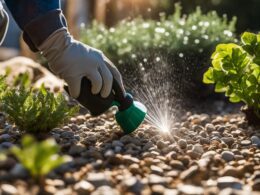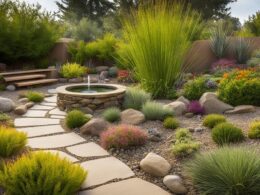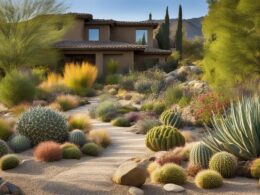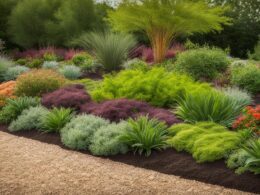Desert landscaping presents unique challenges due to the harsh climate and limited water resources. However, there are several effective strategies for maximizing efficiency and creating a sustainable landscape in arid regions. By embracing water-smart solutions and incorporating native plants and efficient irrigation systems, homeowners can transform their desert gardens into beautiful and eco-friendly spaces.
Key Takeaways:
- Desert landscaping requires efficient strategies to overcome harsh climate and limited water resources.
- Water-smart solutions, including native plants and efficient irrigation systems, are essential for sustainable desert landscapes.
- By maximizing efficiency, homeowners can create beautiful and eco-friendly desert gardens.
- Desert landscaping promotes water conservation and sustainability in arid regions.
- Proper planning and design are crucial for creating efficient and sustainable desert landscapes.
The Ideal Shade Trees for Your Arizona Home
When it comes to landscaping in Arizona, incorporating shade trees is a smart and practical choice. Not only do shade trees provide much-needed relief from the intense desert sun, but they also enhance the overall aesthetics of your outdoor space. Here are some ideal shade trees that thrive in Arizona’s arid climate:
- Mesquite: Known for its durability and drought tolerance, mesquite trees are a popular choice for Arizona landscapes.
- Palo Verde: With its vibrant yellow flowers and green bark, Palo Verde trees add a touch of beauty to any desert garden.
- Mulga: Native to Australia but well-suited for Arizona, Mulga trees feature attractive silver-gray foliage and provide excellent shade.
- Bonita Ash: Bonita Ash trees have a fast growth rate and offer dense shade, making them ideal for creating cooler outdoor living spaces.
- Chinese Elm: Chinese Elm trees are known for their ability to adapt to various soil types and provide ample shade with their spreading canopy.
- Jacaranda: With its stunning purple flowers and elegant foliage, Jacaranda trees make a striking statement in any Arizona landscape.
- Acacia: Acacia trees are not only beautiful but also require minimal maintenance, making them a popular choice for desert landscaping.
- Ironwood: Ironwood trees are renowned for their resilience in desert environments and provide excellent shade with their dense canopy.
By planting these shade trees in your Arizona home, you can create a more comfortable and enjoyable outdoor living space while embracing the natural beauty of the desert landscape.
Table: Shade Trees for Arizona Landscaping
| Tree Name | Key Features |
|---|---|
| Mesquite | Durable, drought-tolerant, and provides filtered shade. |
| Palo Verde | Vibrant yellow flowers, green bark, and provides dappled shade. |
| Mulga | Silver-gray foliage, drought-tolerant, and offers dense shade. |
| Bonita Ash | Fast-growing, dense shade, and requires minimal maintenance. |
| Chinese Elm | Adaptable to different soil types, spreading canopy, and provides ample shade. |
| Jacaranda | Stunning purple flowers, elegant foliage, and adds visual interest. |
| Acacia | Low maintenance, beautiful, and thrives in arid conditions. |
| Ironwood | Resilient, dense canopy, and provides excellent shade. |
Table: Shade Trees for Arizona Landscaping showcasing the key features and benefits of each tree.
Placing Structures for Shade
When it comes to maximizing efficiency in desert landscaping, incorporating shade structures is a key consideration. Shade structures not only provide relief from the intense desert heat but also enhance the functionality and aesthetics of your outdoor living space. By strategically placing covered patios, decks, pergolas, and backyard shade cloths, you can create a cool and comfortable oasis.
Covered patios and decks offer complete shade and protection from the sun’s harmful rays. They provide an ideal space for relaxation, dining, and entertaining. With the addition of features like outdoor kitchens, entertainment centers, and fireplaces, these shaded areas become the ultimate outdoor living spaces.
Pergolas, on the other hand, offer a balance between sunlight and shade. Adorned with vines and hanging plants, pergolas provide partial shade and can create a tranquil and inviting ambiance. Backyard shade cloths, such as awnings, umbrellas, and shade sails, offer temporary relief and flexibility, allowing you to adjust the shade as needed.
Benefits of Shade Structures in Desert Landscaping
- Provides relief from intense desert heat
- Creates comfortable outdoor living spaces
- Enhances the functionality of the landscape
- Protects against the sun’s harmful rays
- Increases the value of your property
By incorporating shade structures into your desert landscaping, you can enjoy the beauty of the outdoors while staying cool and comfortable. Whether you prefer a fully shaded patio or a partially shaded pergola, these structures create inviting spaces that allow you to make the most of your outdoor living area.
Table: Shade Structures Comparison
| Structure | Benefits | Considerations |
|---|---|---|
| Covered Patios |
|
|
| Pergolas |
|
|
| Backyard Shade Cloths |
|
|
As you consider the placement of shade structures in your desert landscaping, it’s important to assess your specific needs and preferences. Take into account factors such as space availability, budget, and desired shade intensity. By carefully selecting and positioning shade structures, you can create a functional and comfortable outdoor living space that truly maximizes efficiency in desert landscaping.
Xeriscaping: Creating Water-Smart Landscapes
Xeriscaping is a water-smart landscaping approach that focuses on using drought-tolerant plants and implementing efficient irrigation systems. By selecting native plants that require less water, homeowners can create beautiful landscapes while minimizing water consumption. Efficient irrigation systems, such as drip irrigation, deliver water directly to plant roots, minimizing evaporation and runoff. Smart technologies like sensors and weather-based controllers ensure precise water management, optimizing water usage in arid regions.
One of the key components of xeriscaping is the use of drought-tolerant plants. These plants have adapted to the arid conditions and require less water to thrive. Some examples of popular drought-tolerant plants include agave, yucca, lavender, and sage. By incorporating these plants into your landscape design, you can reduce the need for excessive watering and still maintain a visually appealing garden.
Efficient irrigation systems are another essential aspect of xeriscaping. Drip irrigation, also known as micro-irrigation, is a highly efficient method that delivers water directly to the roots of plants. This minimizes water loss through evaporation and ensures that each plant receives the necessary amount of water. Smart technologies, such as soil moisture sensors and weather-based controllers, further enhance the efficiency of irrigation systems by adjusting water output based on real-time data.
When implementing xeriscaping techniques, it’s important to consider the layout and design of your landscape. Grouping plants according to their water needs and creating separate irrigation zones can help optimize water usage. Additionally, incorporating mulch and other organic materials can help retain water in the soil and prevent evaporation.
Table: Comparison of Water-Smart Landscaping Techniques
| Technique | Description | Benefits |
|---|---|---|
| Drought-tolerant plants | Native plants adapted to arid conditions, requiring less water | Reduced water consumption, lower maintenance needs |
| Efficient irrigation systems | Methods like drip irrigation deliver water directly to plant roots | Minimized water loss through evaporation, precise water management |
| Smart technologies | Sensors and controllers adjust water output based on real-time data | Optimized water usage, reduced water waste |
| Grouping and zoning | Strategic placement of plants and separate irrigation zones | Efficient water distribution, reduced water waste |
| Mulching | Adding organic materials to the soil to retain moisture | Improved water retention, reduced soil erosion |
The Benefits of Climate-Responsive Landscaping
Climate-responsive landscaping offers numerous benefits in arid regions. By adopting sustainable practices and smart technologies, you can achieve significant water savings while maintaining beautiful and functional landscapes. Let’s explore the advantages of climate-responsive landscaping:
1. Water Conservation
One of the primary benefits of climate-responsive landscaping is water conservation. By using drought-tolerant plants and implementing efficient irrigation systems, you can minimize water usage in arid regions. This not only helps to conserve this precious resource but also reduces your water bills, making your landscape more cost-effective in the long run.
2. Improved Plant Health
Climate-responsive landscaping focuses on selecting plants that are well-suited to the local climate and soil conditions. By choosing native and adapted species, you can ensure that your plants thrive and remain healthy, even in harsh desert environments. This leads to vibrant and flourishing landscapes that require minimal maintenance.
3. Reduced Maintenance Costs
By incorporating climate-responsive practices, you can reduce the amount of maintenance required for your landscape. Native plants are often more resistant to pests and diseases, meaning they require fewer treatments and interventions. Additionally, efficient irrigation systems deliver water directly to the roots, minimizing water loss through evaporation and runoff, and reducing the time and effort needed to maintain plant health.
4. Environmental Benefits
Climate-responsive landscaping has several environmental benefits. By conserving water, you contribute to the overall sustainability of the region and help protect its natural resources. Additionally, native plants support local biodiversity, providing habitat and food sources for native wildlife. Furthermore, by reducing the use of chemical treatments and fossil fuel-dependent practices, climate-responsive landscaping minimizes your carbon footprint and promotes a healthier environment.
5. Enhanced Aesthetics
Finally, climate-responsive landscaping can enhance the aesthetic appeal of your outdoor spaces. By strategically selecting plants that are adapted to the local climate, you can create visually stunning landscapes that harmonize with the natural surroundings. The use of diverse plant species, textures, and colors adds depth and interest to your garden, making it a visually captivating and inviting space.
Harnessing Nature Resilience: Climate-Adaptive Landscaping in Desert Environments
Climate-adaptive landscaping is a transformative strategy that combines nature’s resilience with innovative technologies to create green and habitable spaces in desert environments. By focusing on water conservation, energy efficiency, biodiversity preservation, and carbon sequestration, climate-adaptive landscaping offers a sustainable solution for designing landscapes that thrive in arid regions.
In desert environments, water conservation is paramount. Climate-adaptive landscaping embraces strategies that minimize water usage while still supporting the growth and health of plants. Efficient irrigation systems, such as drip irrigation, deliver water directly to the roots, reducing evaporation and water waste. This approach also incorporates microclimate management techniques to mitigate the harsh desert conditions and provide optimal growing conditions for plants.
Beyond water conservation, climate-adaptive landscaping prioritizes energy efficiency. By strategically placing shade structures, using reflective surfaces, and incorporating natural elements like trees and vegetation, homeowners can create cooler outdoor spaces that minimize the need for excessive air conditioning. This not only reduces energy consumption but also improves the overall comfort and livability of the landscape.
Biodiversity preservation and carbon sequestration
Climate-adaptive landscaping also plays a crucial role in preserving biodiversity and sequestering carbon. By selecting native plants that are adapted to the harsh desert conditions, homeowners can create habitats for local wildlife and promote biodiversity. These plants are often more resilient to drought and require less maintenance, making them ideal for desert landscaping.
Climate-adaptive landscaping allows us to not only create beautiful outdoor spaces but also contribute to the overall health of the environment. By preserving biodiversity and sequestering carbon, we are actively combating the effects of climate change and creating a more sustainable future.
In conclusion, climate-adaptive landscaping offers a comprehensive approach to creating sustainable and resilient landscapes in desert environments. By harnessing nature’s resilience and utilizing innovative technologies, homeowners can design landscapes that thrive in arid regions while conserving water, promoting energy efficiency, preserving biodiversity, and sequestering carbon. Embracing climate-adaptive landscaping principles is not only beneficial for individual homeowners but also contributes to the greater goal of creating a more sustainable and environmentally conscious society.
Designing for the Future: How Climate-Adaptive Landscaping Transforms Desert Projects
Climate-adaptive landscaping is shaping the future of design by transforming arid landscapes into functional and sustainable spaces. As water conservation and biodiversity preservation become increasingly important, homeowners and designers are embracing climate-adaptive landscaping principles to create eco-friendly and resilient landscapes in desert environments.
By incorporating climate-adaptive landscaping techniques, such as proper plant selection, efficient irrigation systems, and attention to design principles, homeowners can achieve beautiful and water-smart landscapes that thrive in the desert environment. This approach not only conserves water but also promotes the preservation of biodiversity, ensuring the long-term health and sustainability of desert ecosystems.
As the future of design continues to evolve, climate-adaptive landscaping offers a solution for creating water-efficient and eco-friendly landscapes in arid regions. By understanding the unique challenges of desert environments and implementing innovative strategies, designers can create landscapes that are not only visually appealing but also environmentally conscious.
The Future of Design in Arid Landscapes
Climate-adaptive landscaping is at the forefront of the future of design in arid landscapes. This approach goes beyond traditional landscaping practices and focuses on creating landscapes that are adapted to the specific challenges posed by desert environments. By taking into account factors such as water conservation, biodiversity preservation, and climate resilience, climate-adaptive landscapes offer a sustainable solution for homeowners and designers alike.
Climate-adaptive landscaping is at the forefront of the future of design in arid landscapes.
Water Conservation and Biodiversity Preservation
One of the key objectives of climate-adaptive landscaping is water conservation. By implementing efficient irrigation systems, such as drip irrigation, and selecting drought-tolerant native plants, homeowners can significantly reduce water usage while still enjoying a lush and vibrant landscape. Additionally, climate-adaptive landscaping promotes biodiversity preservation by incorporating native plants that support local wildlife and contribute to the overall health of the ecosystem.
| Benefits of Climate-Adaptive Landscaping | Key Strategies |
|---|---|
| Water conservation | Efficient irrigation systems, native plant selection |
| Biodiversity preservation | Use of native plants, creation of habitat areas |
| Climate resilience | Microclimate management, soil improvement techniques |
Climate-adaptive landscaping is not only beneficial for the environment but also for homeowners. By reducing water consumption and promoting biodiversity, homeowners can create landscapes that are not only visually stunning but also cost-effective and low-maintenance.
In conclusion, climate-adaptive landscaping is revolutionizing the way we approach design in arid landscapes. By embracing this innovative approach, homeowners and designers can create functional and sustainable landscapes that conserve water, preserve biodiversity, and enhance the overall resilience of desert environments. As the future of design continues to evolve, climate-adaptive landscaping offers a solution for creating beautiful and eco-friendly landscapes that thrive in arid regions.
Water-Wise Landscaping Principle #1: Planning and Design
When it comes to water-wise landscaping, proper planning and design are essential. By carefully considering the needs of your landscape and incorporating efficient water usage strategies, you can create a beautiful and functional outdoor space that conserves water in arid regions. Here are some key considerations for planning and designing your water-wise landscape:
- Choose low-water plants: Selecting plant species that are adapted to arid environments and have low water requirements is crucial. These plants can thrive with minimal irrigation and help reduce overall water consumption.
- Design irrigation zones: Divide your landscape into separate irrigation zones based on water requirements. This allows you to provide the appropriate amount of water to each area, ensuring efficient water usage.
- Utilize hardscaping: Incorporating hardscaping features such as gravel pathways, rock gardens, or mulch beds can help minimize the area that requires irrigation. This not only saves water but also adds visual interest to your landscape.
By implementing these planning and design principles, you can create a water-wise landscape that not only conserves water but also enhances the beauty and functionality of your outdoor space.
Maximizing Efficiency with Irrigation Zone Designs
A key aspect of planning and design in water-wise landscaping is the creation of efficient irrigation zones. By dividing your landscape into separate areas with similar water requirements, you can optimize water usage and minimize wastage. Here are some irrigation zone designs to consider:
| Zone | Water Needs | Irrigation Method |
|---|---|---|
| Low-Water Plantings | Minimal | Drip irrigation or soaker hoses |
| Turf Areas | Moderate | Rotary or oscillating sprinklers |
| High-Water Use Areas | Significant | Impact or gear-driven sprinklers |
By tailoring your irrigation system to the specific needs of each zone, you can avoid overwatering and ensure that water is distributed efficiently. This not only helps conserve water but also promotes healthier plant growth and reduces the risk of water-related issues such as runoff or soil erosion.
Water-Wise Landscaping Principle #2: Soil Preparation
Proper soil preparation is a crucial step in achieving water-wise landscaping. By understanding the characteristics of your soil, such as texture, structure, organic matter content, nutrient status, and pH levels, you can optimize plant growth and water retention, leading to a more efficient and sustainable landscape.
Soil texture refers to the relative proportions of sand, silt, and clay in the soil. Sandy soils drain quickly but often struggle to retain water, while clay soils have better water-holding capacity but can become compacted and poorly drained. Loam soils, a balanced mixture of sand, silt, and clay, offer the best conditions for water movement and retention.
In addition to texture, soil structure is crucial for water-wise landscaping. Well-structured soils have good aggregation, allowing for optimal water infiltration and root growth. Compacted soils, on the other hand, hinder water movement and restrict root development. To improve soil structure, consider incorporating organic matter, like compost or mulch, which helps to create pore spaces for water storage and enhances the soil’s ability to hold moisture.
“Soil preparation is the foundation of water-wise landscaping. Properly understanding your soil’s characteristics and taking steps to enhance its quality can significantly improve water retention and overall plant health.”
Soil organic matter plays a vital role in water-wise landscaping by improving soil fertility and moisture-holding capacity. Organic matter acts as a sponge, absorbing and storing water, while also providing essential nutrients for plant growth. Adding organic matter, such as compost, to your soil can increase its ability to retain moisture, reduce runoff, and support a healthier and more sustainable landscape.
Furthermore, assessing the nutrient status and pH of your soil is essential for water-wise landscaping. Nutrient deficiencies or imbalances can hinder plant growth and water uptake, while an inappropriate soil pH can affect nutrient availability. Conducting a soil test can help identify any deficiencies and allow you to make targeted amendments to optimize nutrient levels and pH, ensuring that your plants can efficiently utilize the available water.
Remember, proper soil preparation is the key to creating a water-wise landscape. By understanding and improving your soil’s texture, structure, organic matter content, nutrient status, and pH levels, you can maximize water retention, support healthy plant growth, and minimize water waste in your landscaping endeavors.
Summary
- Understanding your soil’s characteristics, such as texture, structure, and nutrient status, is crucial for water-wise landscaping.
- Soil texture affects water movement and retention, with loam soils offering the best conditions for optimal water-holding capacity.
- Well-structured soils with good aggregation allow for better water infiltration and root growth.
- Incorporating organic matter, such as compost or mulch, improves soil structure and enhances water retention.
- Soil organic matter acts as a sponge, absorbing and storing water, while also providing essential nutrients for plant growth.
- Conducting a soil test helps identify nutrient deficiencies and pH imbalances, enabling targeted amendments for optimal water-wise landscaping.
| Soil Characteristic | Importance |
|---|---|
| Soil Texture | Affects water movement and retention |
| Soil Structure | Influences water infiltration and root growth |
| Soil Organic Matter | Improves moisture-holding capacity and nutrient availability |
| Nutrient Status | Affects plant growth and water uptake |
| Soil pH | Influences nutrient availability |
Conclusion
In conclusion, maximizing efficiency in desert landscaping requires the implementation of sustainable solutions and water conservation strategies. By embracing the principles of climate-responsive and climate-adaptive landscaping, you can create eco-friendly and resilient landscapes in arid regions.
By carefully selecting low-water plants, incorporating efficient irrigation systems, and planning and designing your landscape with water-smart principles in mind, you can achieve a beautiful and water-wise oasis in the desert. It’s important to consider the unique challenges of desert environments and leverage climate adaptation strategies to create landscapes that thrive in this harsh climate.
Remember, sustainable practices such as xeriscaping, soil preparation, and smart irrigation technologies play a crucial role in maximizing efficiency and conserving water. By implementing these strategies, you not only contribute to water conservation efforts, but also create a visually appealing and environmentally friendly landscape.
So go ahead and transform your desert landscape into a beautiful and sustainable oasis. With the right approach and careful planning, you can create a stunning outdoor space that maximizes efficiency, embraces sustainable solutions, and adapts to the unique challenges of desert living.
How Can Soil Conditioners Help Maximize Efficiency in Desert Landscaping?
When it comes to desert landscaping, using the best soil conditioners for desert is crucial for maximizing efficiency. These conditioners can help improve soil structure, increase water retention, and enhance nutrient uptake, resulting in healthier plants that are more resistant to the harsh desert environment.
FAQ
What are some effective strategies for maximizing efficiency in desert landscaping?
Embracing water-smart solutions, incorporating native plants, and implementing efficient irrigation systems are effective strategies for maximizing efficiency in desert landscaping.
What are some ideal shade trees for Arizona landscaping?
Some ideal shade trees for Arizona landscaping include mesquite, Palo Verde, Mulga, Bonita Ash, Chinese Elm, Jacaranda, Acacia, and Ironwood.
What shade structures can be used in desert landscaping?
Shade structures such as covered patios, decks, pergolas, and backyard shade cloths (e.g., awnings, umbrellas, shade sails) can be used in desert landscaping to provide relief from the intense desert heat.
What is xeriscaping?
Xeriscaping is a water-smart landscaping approach that focuses on using drought-tolerant plants and implementing efficient irrigation systems to create beautiful landscapes while minimizing water consumption.
What are the benefits of climate-responsive landscaping in arid regions?
Climate-responsive landscaping promotes improved plant health, reduced maintenance costs, environmental benefits (such as soil health and biodiversity preservation), and enhanced visual appeal in arid regions.
How does climate-adaptive landscaping transform desert environments?
Climate-adaptive landscaping combines nature’s resilience with technological innovations to create green and habitable spaces in arid regions. It focuses on water conservation, energy efficiency, biodiversity preservation, and carbon sequestration.
How does water-wise landscaping incorporate planning and design?
Water-wise landscaping involves careful planning and design, including the selection of low-water plants, designing irrigation systems with separate zones based on water requirements, and utilizing hardscaping materials to minimize the area requiring irrigation.
Why is soil preparation important in water-wise landscaping?
Soil preparation is essential for optimizing plant growth and water retention in water-wise landscaping. Understanding soil characteristics such as texture, structure, organic matter content, nutrient status, and pH levels helps homeowners enhance soil quality and water-holding capacity.
How can homeowners maximize efficiency in desert landscaping?
Homeowners can maximize efficiency in desert landscaping by embracing sustainable solutions, implementing water conservation strategies, and utilizing climate-responsive and climate-adaptive landscaping techniques.














